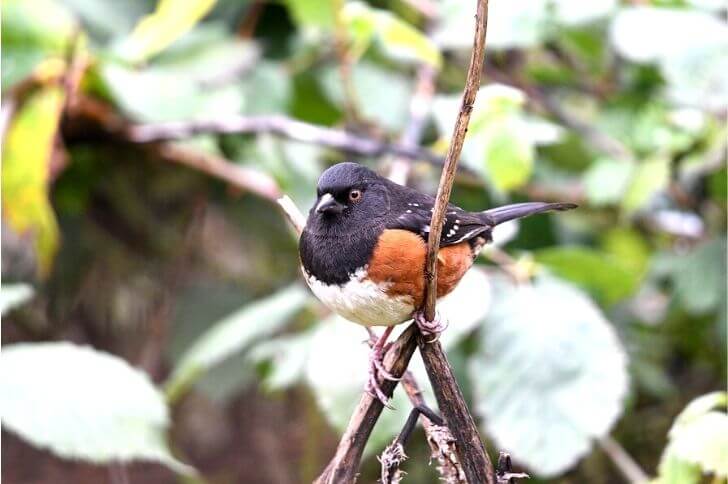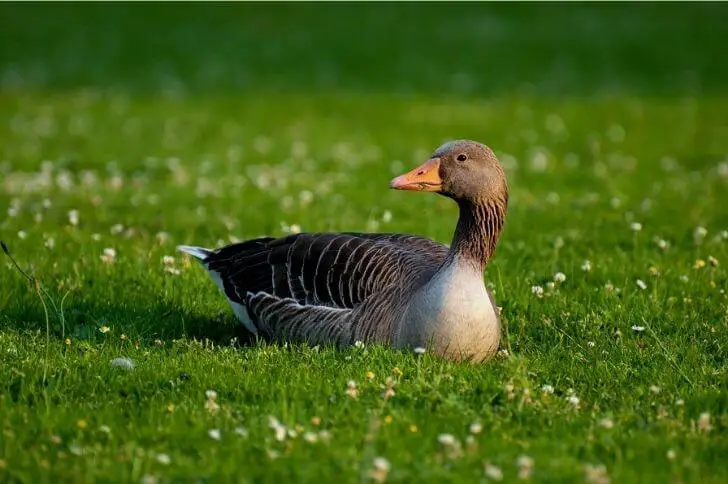Red birds with black heads are a common sight across the world. In North America, birds like the Northern Cardinals fit this category. In Africa you can watch the Black-headed gonolek while the Rosy thrush-tanager is a resident breeder in Mexico.
Below we’ll discuss the above birds and more. We’ll look at their unique characteristics, breeding habits and more. Keep reading on if you want to add a few names to your birding journal.
List of Red Birds with Black Heads
1. Northern Cardinal (Juvenile)
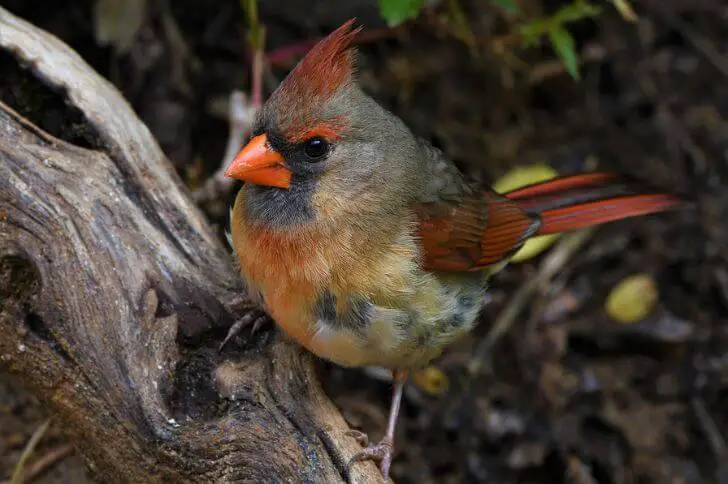
The northern cardinal is one of the most popular and easily recognizable birds in North America. And the juvenile fits this category of red birds with black heads.
Identification:
The male’s bright red plumage is a familiar sight in backyards and gardens across the continent. Females have the same body size as males; 8.3-9.1 inches. They are a pale brown overall with hints of red on the crest and tail.
The juvenile cardinals molt is a bright red on its body and black on its head. So, if you come across a young red bird with black head in your yard it is most probably a cardinal going through the molting process.
Interesting facts:
These songbirds are not only beautiful, but also interesting and intelligent creatures. Although they are commonly seen alone or in pairs, northern cardinals will form large flocks during the winter months.
They are also known to mate for life. Cardinals are one of the few bird species that actually benefit from human activity, as they often nest near houses and feed on seeds and berries provided by people.
With their cheerful songs and vibrant plumage, northern cardinals are a welcome addition to backyard bird feeders.
2. Red Siskin
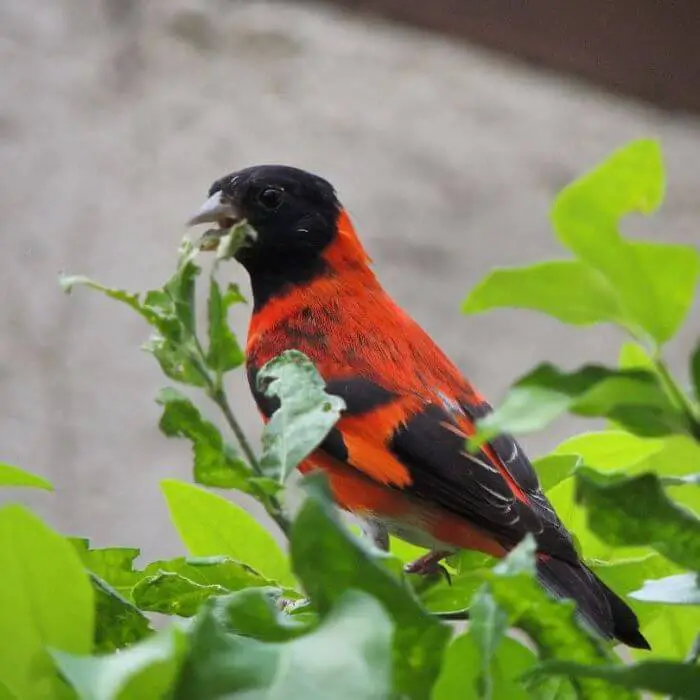
Red Siskin – Spinus cucullatus
source: zoo_lesliepantin
Found in South America, the red siskin is a small, striking finch that has been listed as an endangered bird.
Identification:
With brilliant red plumage and a round head, red siskins are gorgeous open country birds. Adult males are all-red with black wings and head feathers. Also note the slightly forked tail.
On the other hand females are more gray with hints of red on their rump. Male fledglings are pale brown.
Interesting facts:
These red birds with black heads are small, about 4 inches long. They favor the forests of the northern Andes. Also the red siskin is an important part of Venezuelan culture.
It is considered good luck to have one. And due to habitat loss and illegal trapping for pet trade, the red siskin is at the brink of extinction.
3. Black-headed Gonolek
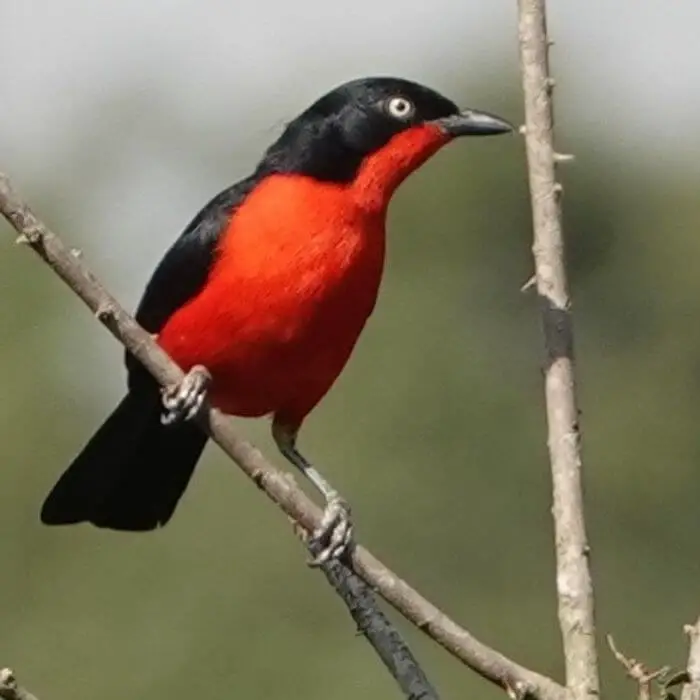
The black-headed gonolek. Yah! I also found the name funny. But that aside, it’s a very beautiful bird to watch.
Identification:
It is a small, insectivorous bird found in the forests of Central and West Africa. It is a member of the Malaconotidae family and is closely related to bushshrikes and boubou.
Sexes look alike. Adults have black upperparts and red below. Not the small slightly hooked bill and whitish undertail coverts. Notice the striking yellow eyes.
Other facts:
These black headed red birds feed mainly on insects, but will also eat small reptiles, other birds eggs and fruits. It nests in hollow trees or termite mounds and lays 2-4 eggs at a time.
Related Read: List of Red Chested birds
4. Crimson-breasted Shrike
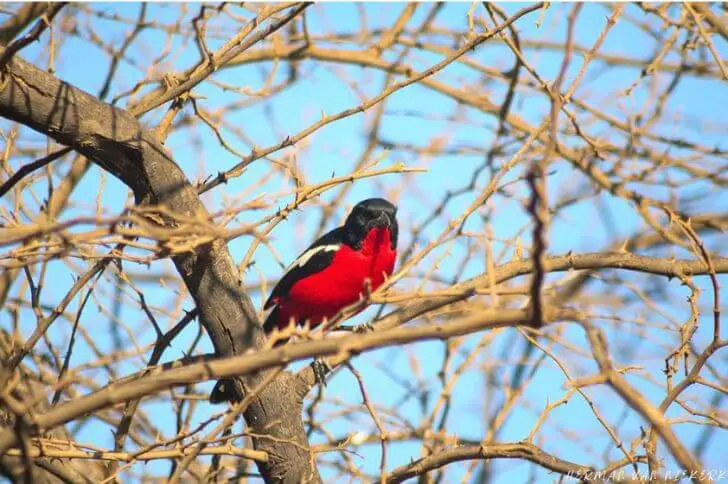
source: hvn_wildlife_photography
A red and black bird in the same family as the black-headed gonolek above, the crimson-breasted shrike is a small passerine bird that is native to sub-Saharan Africa.
Identification:
The bird is easily recognizable by its distinctive plumage, which consists of a black head and upper body, with white stripes on its wings. Underparts are stunning red. The bird is also known for its loud, shrill whistle.
Other facts:
This red body black head bird is found in open woodlands, savannahs, and scrublands. It feeds primarily on insects, but will also eat lizards. The bird catches its prey by perching on a branch and then swooping down on flying insects.
The crimson-breasted shrike is an important part of the African ecosystem as it helps to control the population of insects. The bird is also considered to be a symbol of good luck in many African cultures.
5. Rosy Thrush-tanager

source: redhillbirding
Found in parts of Mexico, the rosy thrush-tanager is one of the most beautiful birds in the region.
Identification:
It is a medium-sized bird, with a long tail and a red-colored body. The male has a black head and back. The female is black above and orange below. Both sexes have a white eyebrows and long, slightly hooked bills.
Interesting facts:
The rosy thrush-tanager is also found in the highlands of Costa Rica, where it inhabits forests and edges. It feeds on insects, berries, and fruits. The bird breeds from January-September in Costa Rica and July in Mexico.
The female lays two to six eggs in a nest made of leaves, grasses, and twigs, which is built in a tree or bush.
6. Crimson-breasted Finch
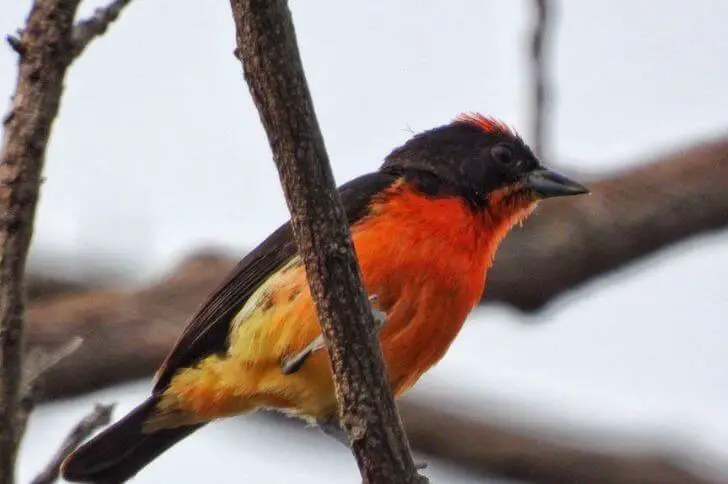
source: jdtomala
Crimson-breasted finches are one of the most beautiful and popular birds in Peru.
Identification:
Also called the crimson finch-tanager, they are known for their brilliant red underparts, which is most visible on the male birds. Their upperparts are black with a small red crown.
Females are tan in color. Also notice their buff breasts. Both males and females have canonical bills. These birds are relatively small, measuring only about 5-6 inches in length.
Other facts:
These birds with black heads are found in open woodlands and forests across the continent. They build their nests in trees or shrubs, usually near the ground. These birds are not shy around humans and will often approach people looking for food.
Crimson-breasted finches eat a variety of insects. These lovely little birds are a joy to watch and listen to.
7. Crimson-backed Tanager (Female)
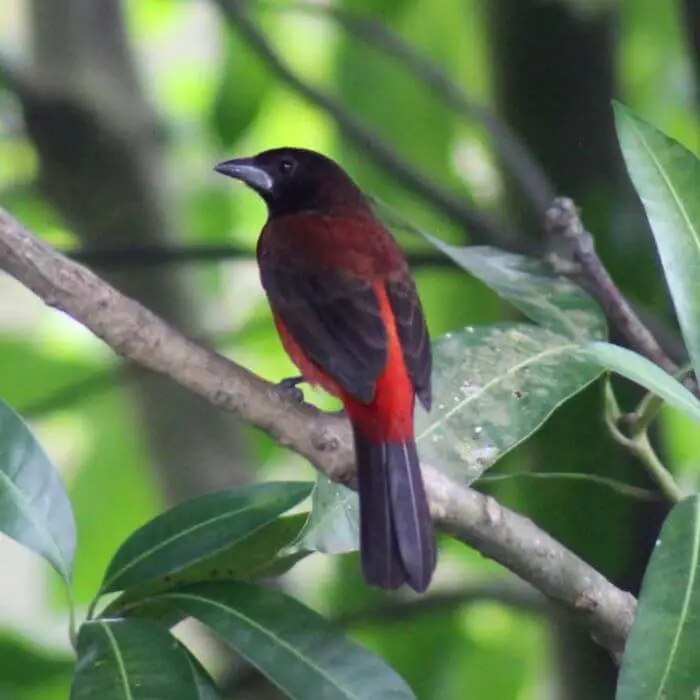
source: aniyaki
Not to be confused with the crimson-finch tanager above, the crimson-backed tanager is a beautiful black and red bird that is native to Central America.
Identification:
Measuring about 7 inches in length, the male of the species is bright red with a black back. Head is also red with a slight black tinge. Females are also red and with a black head. Both sexes sport short bills; male have a white mandible. The bird has a long, rounded tail and long, thin legs.
Other facts:
Its diet consists primarily of insects, but it will also eat fruit. The crimson-backed tanager typically nests in trees or shrubs, but it will also nest in caves or on cliffs. The bird typically lays two to four eggs at a time, which hatch after about two weeks.
8. Pesquet’s Parrot
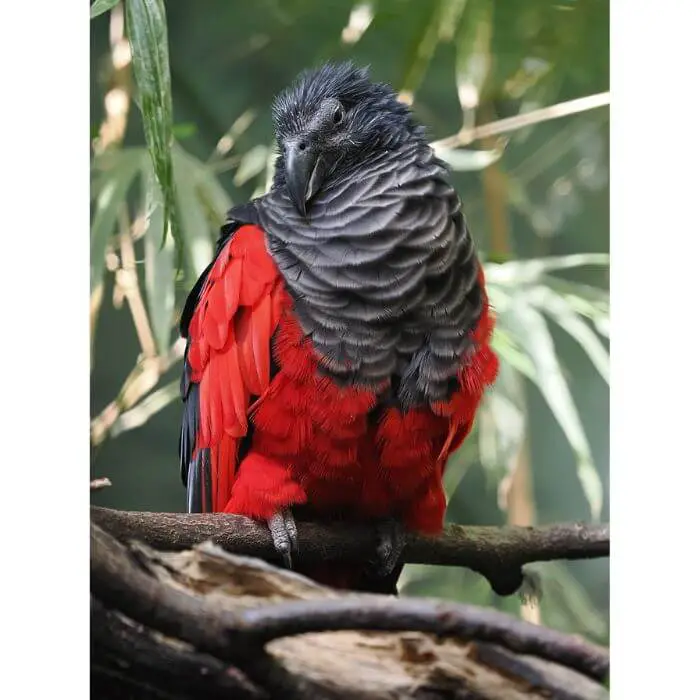
Identical to the Vulturine parrot, the Pesquet’s parrot is a large and stunning bird that is native to New Guinea. And unlike their counterparts, their numbers have been rapidly decreasing over recent years, leading to them being added to the IUCN list of endangered birds.
Identification:
It is a medium size member of the parrot family, and is easily recognized by its impressive size and distinctive plumage. On average, the adult is about 18 inches in length with a body mass of up to 28 oz.
As for the plumage, the adult has a red belly and black and red wing feathers. Its upper parts are all black. It gets its name from the vulture-like head feathers.
Other facts:
The Pesquet’s parrot is a highly social bird, and forms small flocks that can often be seen roosting in trees or flying overhead in search of food. These birds are known for their playful nature, and often engage in antics with each other.
They are also very vocal, and their loud calls can often be heard echoing through the forest canopy. Their diet consists of figs and nectar.
Also read: Long Necked birds
9. Maroon Oriole

source: allenlyu1202
Small and stunning, the maroon oriole is an Asian red bird with black head that is closely related to the golden oriole.
Identification:
It gets its name from the maroon coloration on its body; but it’s more reddish. The Maroon Oriole is a medium-sized bird that measures about 7 to 8 inches in length.
It has a black head and wing feathers. The Maroon Oriole has a long, pointed tail.
Other facts:
The Maroon Oriole feeds on insects, berries, and nectar. It nests in trees and shrubs. The Maroon Oriole is not currently considered to be at risk of extinction and you can watch its nesting season from April through May.
10. White-capped Redstart

Known for its distinctive white cap, the white-capped redstart is a small red and black bird that prefers mountain streams of Asia.
Identification:
These birds are easily recognizable with their black upperparts and wine-red underparts. Also note the distinctive white cap and dark feet.
Other facts:
This species is insectivorous, feeding on insects and spiders. The white-capped redstart nests in cavities in trees or cliffs, and typically lays three to five eggs per clutch. This species is not considered threatened or endangered.
11. Western Bluebill

source: drgirishgm65
Another red bird with black head that calls the savannas of Africa home is the Western Bluebill.
Identification:
It is a member of the estrildidae family; closely related to the beautiful firetail birds. The male and female look similar. They are red and black. And you can distinguish the sexes by their bills. Males have blue red-tipped bills while females just have a blue bill.
Other facts:
When can you see the western bluebill young? In August through December. Their clutch consists of 3-6 eggs that females sit on for two weeks. Young birds stay with parents for six weeks before venturing out on their own.
12. Purple-bellied Lory

source: parrots_lover
Another member of the psittaculidae family that belongs to this group of red birds with black heads are the purple-bellied lory.
Identification:
The adult Purple-bellied Lory is mostly crimson, with beautiful green black-tipped wings and a purple belly. The head sports a black cap. Juveniles are similar to adults but with duller colors. This species can reach a length of about 10 inches (26 cm), with a wingspan of about 13 inches.
Other facts:
Preferring tropical mangrove forests, these 10-inch birds typically eat fruits. The Purple-bellied Lory typically nests in tree hollows, laying 2-3 eggs per clutch.
13. Black-faced Firefinch
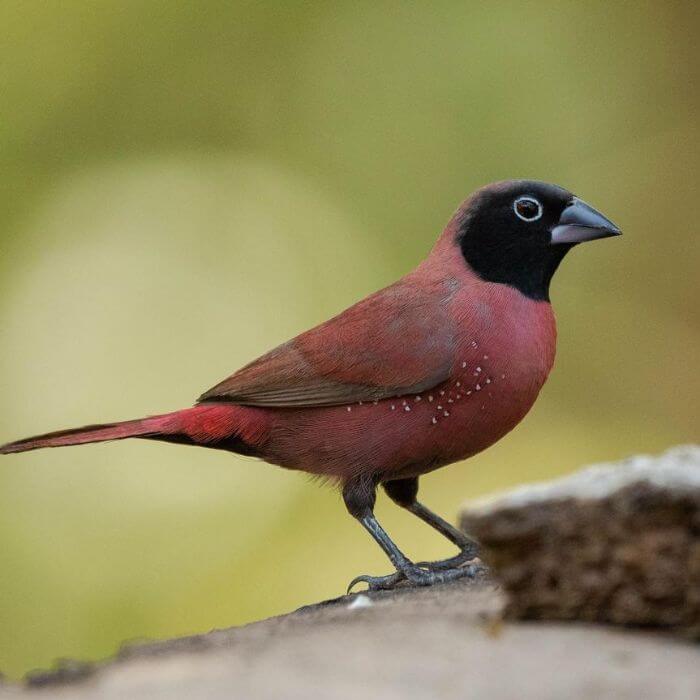
source: frisianbirder
The black-faced firefinch is a small, colorful songbird that is native to Africa.
Identification:
The body of the black-faced firefinch is red, with a black mask and dark brown wings. The bird is found in woodlands and scrublands across Africa. It feeds on seeds. Its populations are stable.
Final Thoughts on red birds with black heads
Though not commonly found in North America, black headed red birds are a beautiful sight to behold. In the United States, juvenile male cardinals fit these descriptions. During molting season they sport a black head and red body.
Other parts of the world, especially Africa, have many birds that fit this category. If you are going for a birding safari, the list above will be quite helpful.
Source:
https://www.audubon.org/field-guide/bird/northern-cardinal
https://en.wikipedia.org/wiki/Crimson-backed_tanager
Hi fellow bird watcher. Welcome to our small corner of the world. At the spanishbirdguides.com our mission is to share with other bird watchers the things we love about birds, where to go bird watching within the United States, and more. I’d also love to hear from you. Feel free to contact me about your bird watching escapades, share videos, photos and more.
